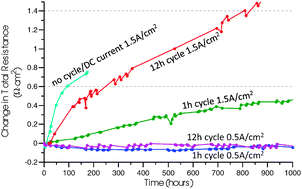Life testing of LSM–YSZ composite electrodes under reversing-current operation
Abstract
Durability testing of solid oxide cell electrodes in reversing-current and constant-current operation modes is presented. (La0.8Sr0.2)0.98MnO3−δ–Zr0.84Y0.16O2−γ (LSM–YSZ) symmetric cells were tested at 800 °C in air with current densities of 0.5 and 1.5 A cm−2, with current cycle periods of 1 and 12 h. A continuous increase in both ohmic and polarization resistance was observed, via Electrochemical Impedance Spectroscopy (EIS), for cells tested with a reversing current of 1.5 A cm−2, whereas cells tested at 0.5 A cm−2 showed no measurable resistance increase. The resistance degradation was explained by delamination in the electrode, observed by post-test Scanning Electron Microscopy (SEM), near the interface with the electrolyte for the 1.5 A cm−2 cells, but not for those tested at 0.5 A cm−2. Current cycle period also impacted the degradation observed at 1.5 A cm−2: both the rate of resistance increase and the extent of post-test delamination decreased on going from constant current mode to a 12 h period to a 1 h period. The results indicate that lower current densities and reversing-current operation are desirable to maximize the lifetime of solid oxide cells.


 Please wait while we load your content...
Please wait while we load your content...